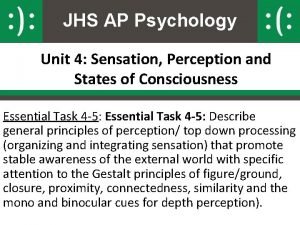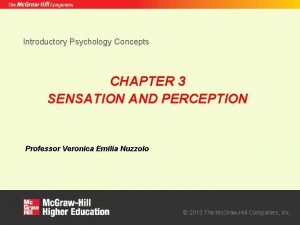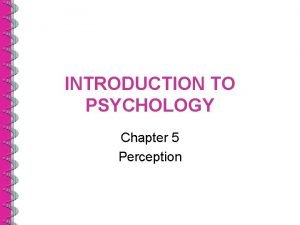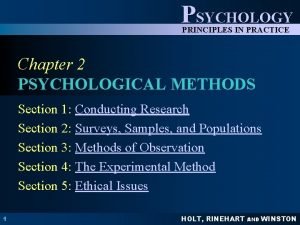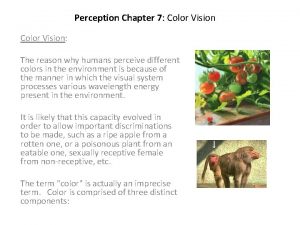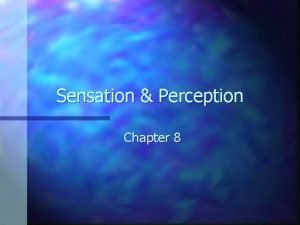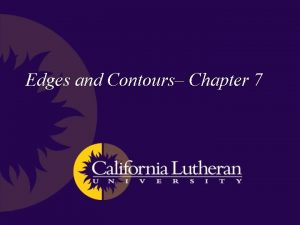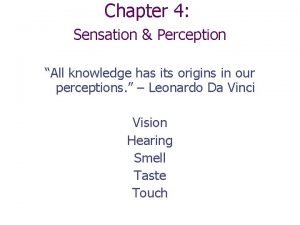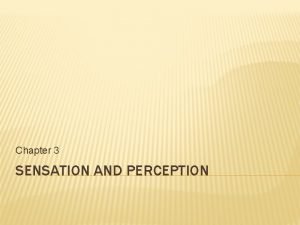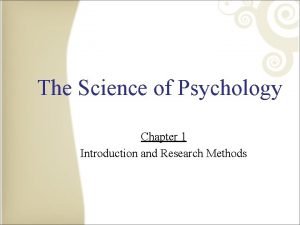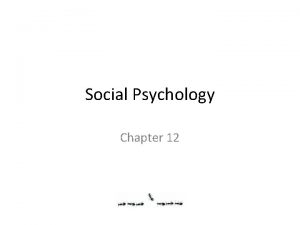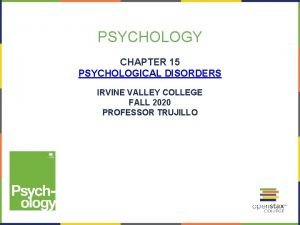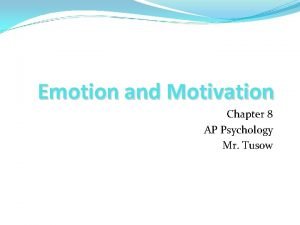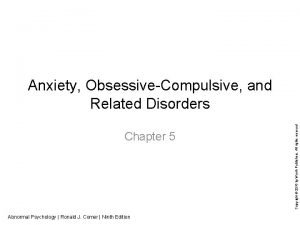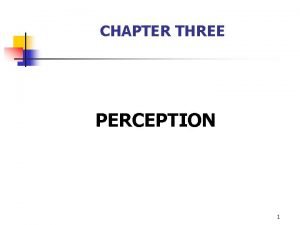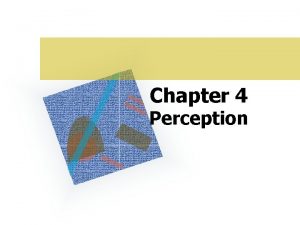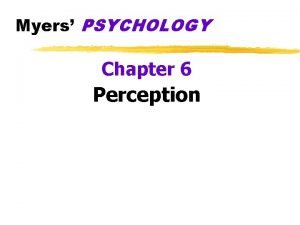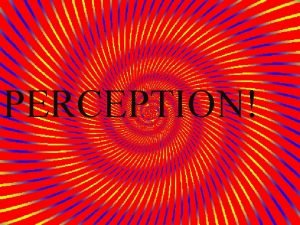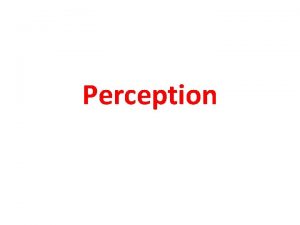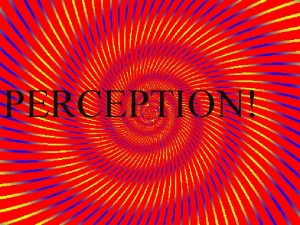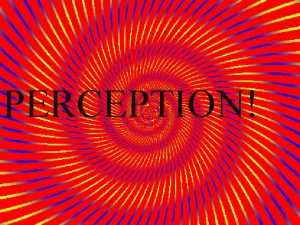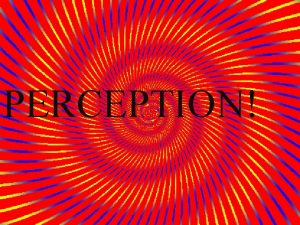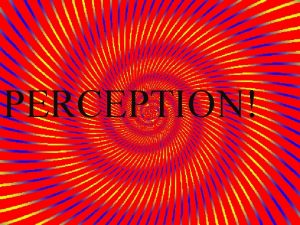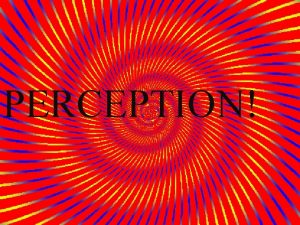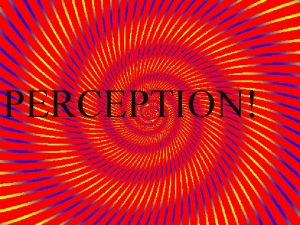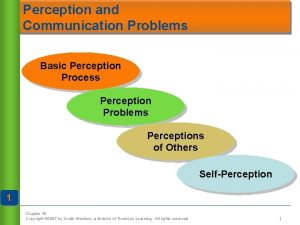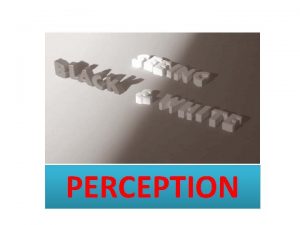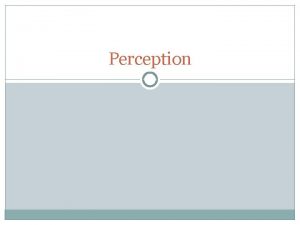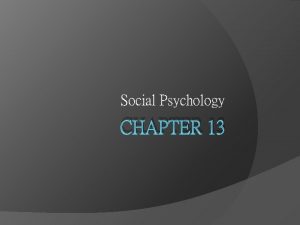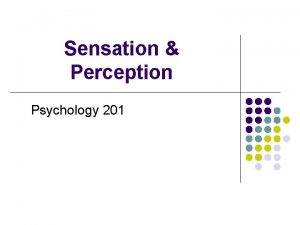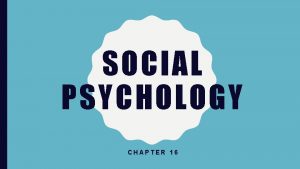PSYCHOLOGY CHAPTER 4 SECTION 5 PERCEPTION Perception is




































- Slides: 36

PSYCHOLOGY CHAPTER 4 SECTION 5: PERCEPTION

• Perception is the way in which we organize or make sense of our sensory impressions.

RULES AND PERCEPTIONAL ORGANIZATION • Gestalt psychologists applied the principle that “the whole is more than the sum of its part” to the study of perception. • They noted many different ways in which people make sense of sensory information. • These ways are called the rules of perceptual organization and include closure, figure-ground perception, proximity, similarity, continuity, and common fate.

CLOSURE

CLOSURE • What you are doing with the image is filling in the blanks. • Gestalt psychologists refer to this as the principle of closure. • Closure is the tendency to perceive a complete or whole figure even when there are gaps in what your senses tell you.


FIGURE-GROUND PERCEPTION • Perception of figures against a background. • What we perceive as the figure and what we perceive as the background influence our perception.


OTHER RULES OF ORGANIZATION • Proximity – or nearness


• Similarity- people think of similar objects as belonging together.


• Continuity • People usually prefer to see smooth continuous patterns, not disrupted ones.


• Common fate • You assume that they are part of the same group and that they are all running to the same place- that they have a common fate.

PERCEPTION OF MOVEMENT • To be able to sense movement, humans need to see an object change its position relative to other objects.

• One way to know if you are moving is to look at objects that you know are stable, like buildings, signs, or trees. •

STROBOSCOPIC MOTION • Stroboscopic motion- illusion of movement is produced by showing the rapid progression of images or objects that are not moving at all. • Example (movies)


DEPTH PERCEPTION • Depth means distance away.

MONOCULAR CUES FOR DEPTH • Need only one eye to be perceived. • Monocular cues cause certain objects to appear more distant from the viewer than others. • These cues include perspective, clearness, overlapping, shadow, and texture gradient.


MOTION PARALLAX • The most complex of monocular cues for depth is called motion parallax. • Tendency of objects to seem to move forward or backward depending on how afar away they are from the viewer.


BINOCULAR CUES FOR DEPTH • Both eyes are required for depth. • Two binocular cues for depth are retinal disparity and convergence.

• Retinal disparity • the way that your left eye and your right eye view slightly different images.

• Convergence • Associated with feelings of tension in the eye muscle. • (Magic eye)


PERCEPTIONAL CONSTANCIES • The reason you know your friends are not getting larger when you move closer to them or the reason a pet owner knows their pet from every angle is due to experience. • Each person creates perceptual constancies of size, color, brightness, and shape.

SIZE CONSTANCY • Through experience, people acquire a sense of size constancy. • Without constancy, you may think a buffalo far away is the same size as an insect close up.

COLOR CONSTANCY • Color constancy is the tendency to perceive objects as keeping their color even though different light might change the appearance of their color.

BRIGHTNESS CONSTANCY • The tendency to perceive an object as being equally bright even when the intensity of the light around it changes.

SHAPE CONSTANCY • The knowledge that an item has only one shape no matter what angle you view that item from. • Example: top of a glass.

VISUAL ILLUSIONS • Do your eyes play tricks on you? • Actually, your eyes are not to blame, but your brains use of perceptual constancies is at fault.

• Muller-Lyer Illusion • Which line at the top is longer?

• Ponzo illusion
 Copyright ?
Copyright ? Group polarization psychology definition
Group polarization psychology definition Retinal disparity psychology
Retinal disparity psychology Perception meaning in psychology
Perception meaning in psychology Categorical perception psychology
Categorical perception psychology What are sensations
What are sensations Constancy psychology
Constancy psychology Chapter 2 psychological methods
Chapter 2 psychological methods Chapter 10 section 1 meiosis
Chapter 10 section 1 meiosis Positive psychology ap psychology definition
Positive psychology ap psychology definition Fundamental attribution error ap psychology
Fundamental attribution error ap psychology Branches of psychology pdf
Branches of psychology pdf Social psychology definition psychology
Social psychology definition psychology Health psychology definition ap psychology
Health psychology definition ap psychology Chapter 5 sensation and perception
Chapter 5 sensation and perception Chapter 7 vision and perception
Chapter 7 vision and perception Chapter 3 sensation and perception
Chapter 3 sensation and perception Chapter 6 sensation and perception
Chapter 6 sensation and perception Kinesthesis and vestibular sense
Kinesthesis and vestibular sense Chapter 8 sensation and perception
Chapter 8 sensation and perception Horizontal e vertical
Horizontal e vertical Chapter 4 sensation and perception
Chapter 4 sensation and perception Chapter 3 sensation and perception
Chapter 3 sensation and perception Revolved view
Revolved view Removed view
Removed view Cutting plane line symbol
Cutting plane line symbol What is the definition of chemical potential energy
What is the definition of chemical potential energy Ap psychology chapter 14
Ap psychology chapter 14 Operational definition examples behavior
Operational definition examples behavior Chapter 12 social psychology
Chapter 12 social psychology What are the 10 personality disorders
What are the 10 personality disorders Over justification affect
Over justification affect Comer abnormal psychology
Comer abnormal psychology Psychology chapter 10 infancy and childhood
Psychology chapter 10 infancy and childhood Chunking psychology definition
Chunking psychology definition Psychology ciccarelli 5th edition
Psychology ciccarelli 5th edition Psychology chapter 10 infancy and childhood
Psychology chapter 10 infancy and childhood


